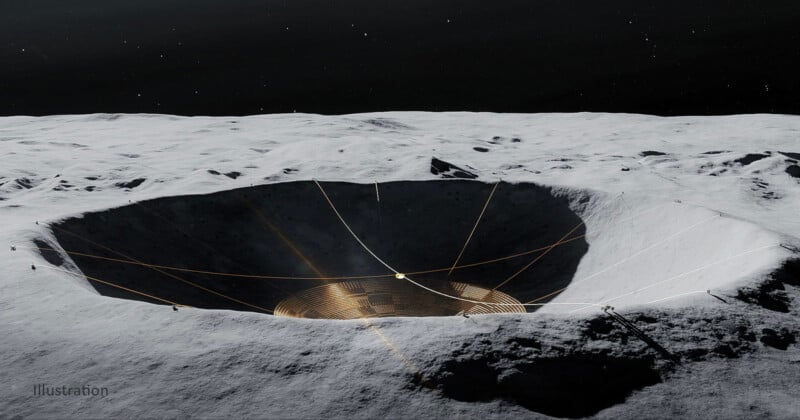NASA Plans to Build Giant Telescope on Dark Side of the Moon for Good Reason

NASA is planning to construct a large, autonomous radio telescope on the dark side of the Moon, aiming to save humanity’s view of the universe from Earth-orbiting satellites.
The proposed Lunar Crater Radio Telescope (LCRT), currently under development at NASA’s Jet Propulsion Laboratory (JPL), could begin construction in the 2030s if fully approved and funded, according to Live Science.
Radio telescopes are a type of telescope that detect radio waves emitted by objects in space, instead of visible light. It’s used in radio astronomy to observe celestial phenomena like stars, galaxies, and black holes, which all emit radio frequencies.

The LCRT would be built inside a naturally occurring lunar crater, spanning approximately 1,150 feet (350 meters) across. Designed to operate without human presence, the telescope would be assembled entirely by robotic systems. The project team has already identified a suitable crater in the Moon’s northern hemisphere, though its exact location remains undisclosed.
Gaurangi Gupta, a research scientist at JPL, tells Live Science that “with state-of-the-art technology, LCRT can make this concept a reality.”

NASA’s interest in a Moon-based observatory is driven in part by rising levels of radio frequency interference (RFI) from satellite constellations such as SpaceX’s Starlink. These private satellites increasingly emit unintended radio signals that compromise ground-based observations of faint cosmic phenomena.
Scientists warn that if satellites surrounding planet Earth reach maximum capacity, “it would mean that we are artificially closing windows to observe our universe,” Frederico Di Vruno, co-director of the International Astronomical Union’s Center for the Protection of the Dark and Quiet Sky, tells Live Science.
Earth’s atmosphere also blocks ultra-long radio wavelengths, signals longer than 33 feet (10 meters), which are essential for studying the early universe, a period known as the cosmic dark ages. During this epoch, the universe was composed mainly of neutral hydrogen, photons, and dark matter.
“Observations of the dark ages have the potential to revolutionize physics and cosmology by improving our understanding of fundamental particle physics, dark matter, dark energy, and cosmic inflation,” Gupta adds.

The project originated in 2020 with initial funding from NASA’s Innovative Advanced Concepts (NIAC) program. It has since progressed to Phase II, receiving a total of $625,000 in early-stage development funding. A 200:1 scale prototype is currently being constructed and is slated for testing later this year at the Owens Valley Radio Observatory in California. If successful, the project could advance to Phase III funding in 2026 and become a formal NASA mission.
However, the projected cost — roughly $2.6 billion — poses a major hurdle, particularly given fiscal constraints within NASA’s current budget. Despite that, proponents argue the telescope is vital for preserving radio astronomy as satellite interference increases.
While the LCRT would represent the most ambitious lunar observatory yet, it follows smaller-scale efforts to study radio signals from the Moon. In February 2024, NASA’s ROLSES-1 instrument aboard Intuitive Machines’ Odysseus lander captured the first radio data from the Moon’s surface. But because the lander was on the Moon’s near side, the data was largely dominated by signals from Earth.
“This is a good demonstration of why we need to be on the far side for reliable measurements of the dark ages signal in a radio-quiet environment,” Gupta says.
Image credits: Vladimir Vustyansky